Thursday, 21 June 2012: Avranches to l'Aigle, via the Mortain offensive and the Falaise pocket
Written 17 July 2012
So there we were, done with Mont Saint Michel and with two full days and a night to get to the airport, northwest of Paris! So what, we asked ourselves, spreading the map on the breakfast table, shall we do between here and there? Our dinner and hotel reservations were in the town of l'Aigle, chosen solely for (1) being halfway between Avranches and Paris and (2) having a highly rated restaurant. We had time to take the scenic route, so David decided that, on our way out of Normandy, he wanted to see the terrain around Mortain, for which the Mortain offensive is named. After the Avranches breakout, the Germans were anxious to reestablish their line from sea to sea, as it were, confining the allies to the Normandy peninsula, and the Mortain offensive was their effort to do that. (And, in asking David to explain that to me, I learned that, for all the hoopla about Patton in Avranches, General Bradley actually conducted the breakout. Patton did pass through there as part of that operation, but only after it was he put in charge of the army with which he performed all his famous exploits. They covered ground, too! It was Patton who relieved Bastogne, way the heck up in Belgium some time later.)
The Mortain offensive failed, but it pushed far enough west that, when it lost momentum, a whole lot of Germans found themselves between the main body of the allied troops to the north and Patton, newly in charge of the Third Army, swinging around them to south. The two allied groups tried to complete the encirclement, the "pocket," but a narrow gap remained at Falaise. The Germans had to abandon tons of equipment, but most of their people got out through that gap and escaped the encirclement. David's proposed route would take us through there as well, then on to l'Aigle.
Okay, how about the day after? Anything interesting to see along the way? Whoa! Wait a minute! Versailles was between us and Paris! Decision made.
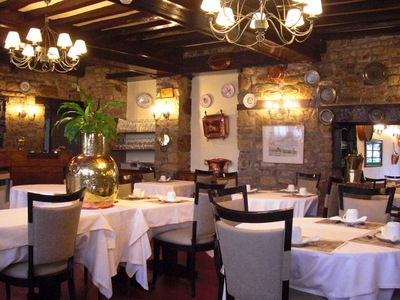
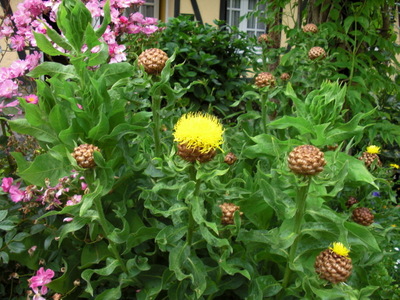 Before leaving the Croix d'Or, though, I took these photos of its handsome old-coaching-inn-style dining room and, in the garden courtyard, this large, very thistle-like yellow flower. I also got shots (not shown here) of the broken whirligig in the courtyard for my father (a classic man-milking-a-cow design, but its windmill was missing a vane, so we never saw in him action; my father, who designs and builds whirligigs, could have fixed it for them if he'd been there) and, nearby, a whimsical life-sized man made of scrap metal, reminiscent of the one on the FSU campus, near Oglesby Union (the one in Avranches was made in 2008 by the young people of the "Accueil de loisirs Tohu-Bohu and of Espace mosaïque, in cooperation with the artist Granvillais Marc Dupart," entirely made of salvaged materials. (An "accueil de loisirs" is a sort of vacation and after-school program, and I think "tohu-bohu" means something like "hurly-burly.")
Before leaving the Croix d'Or, though, I took these photos of its handsome old-coaching-inn-style dining room and, in the garden courtyard, this large, very thistle-like yellow flower. I also got shots (not shown here) of the broken whirligig in the courtyard for my father (a classic man-milking-a-cow design, but its windmill was missing a vane, so we never saw in him action; my father, who designs and builds whirligigs, could have fixed it for them if he'd been there) and, nearby, a whimsical life-sized man made of scrap metal, reminiscent of the one on the FSU campus, near Oglesby Union (the one in Avranches was made in 2008 by the young people of the "Accueil de loisirs Tohu-Bohu and of Espace mosaïque, in cooperation with the artist Granvillais Marc Dupart," entirely made of salvaged materials. (An "accueil de loisirs" is a sort of vacation and after-school program, and I think "tohu-bohu" means something like "hurly-burly.")
So, bidding farewell to Kevin, the friendly English waiter who works at the Croix d'Or, we headed off on the WWII trail. Mostly it was a scenic drive. Twice we tried to visit museums that turned out no longer to be there, and we admired a great deal of lovely countryside. Between Mortain and Falaise, we passed through Vire, where the veritable andouille comes from. As before when we've visited areas of France famous for their pork products, we kept a sharp eye out but saw not one pig. Sheep, yes; cattle, yes; occasionally goats; but never pigs or poultry. I'm convinced French law forbids the rearing of pigs or poultry within sight of a public road.
Vire is located in the Vaux de Vire (the Vale of Vire), which is, the locals claim, the origin of the word Vaudeville. The area was apparently known for its style of satirical and topical songs, and in particular for a published collection of them called "Vaux de Vire."
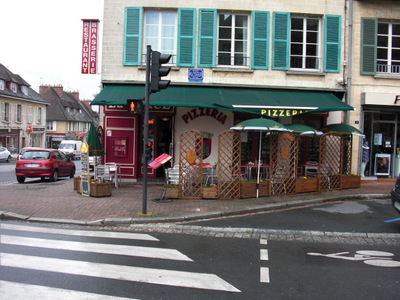
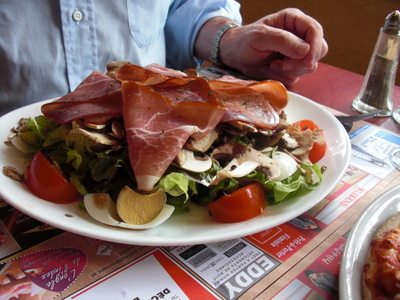 Besides its WWII exploits, Falaise is famous for being the birthplace of William the Conqueror, son of a local girl who got involved with, but was never married to, the king. The castle where he was born is a ruin, and we didn't take time to do the tour (David and I had done it before), and the local WWII museum was gone, but by the time we got that far, we were starved. For lunch we stopped at this nameless little pizzeria, where we had an excellent lunch.
Besides its WWII exploits, Falaise is famous for being the birthplace of William the Conqueror, son of a local girl who got involved with, but was never married to, the king. The castle where he was born is a ruin, and we didn't take time to do the tour (David and I had done it before), and the local WWII museum was gone, but by the time we got that far, we were starved. For lunch we stopped at this nameless little pizzeria, where we had an excellent lunch.
David had his usual salad, extravagantly draped with raw ham.
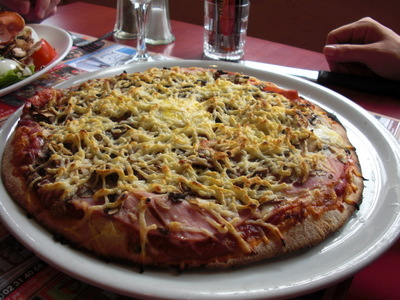
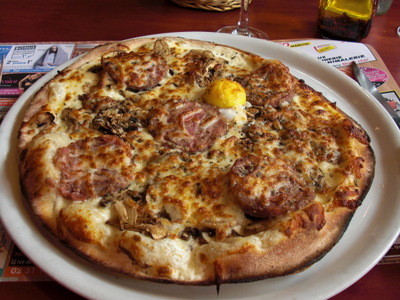 CJ and I had terrific pizzas, her's on the left, thickly latticed with cheese, and mine on the right, topped with slices of andouille and with an egg baked on top. On each table was a graceful bottle of olive oil with a handfull of peppers in the bottom. I drizzled a little on part of my pizza by way of experiment and found that those peppers packed quite a kick!
CJ and I had terrific pizzas, her's on the left, thickly latticed with cheese, and mine on the right, topped with slices of andouille and with an egg baked on top. On each table was a graceful bottle of olive oil with a handfull of peppers in the bottom. I drizzled a little on part of my pizza by way of experiment and found that those peppers packed quite a kick!
From Falaise, we pushed on through Argentan to l'Aigle, where we had dinner and room reservations at the Hôtel du Dauphin, another historic coaching inn. The name of the town means "the eagle"; apparently an eagle's nest was discovered during construction of the local castle. Our room overlooked an open square that, on some days, is a market, but while we were there it was in use as a parking lot. As we settled in and got ready for dinner, we enjoyed listening to someone who was playing stride piano somewhere around the square.
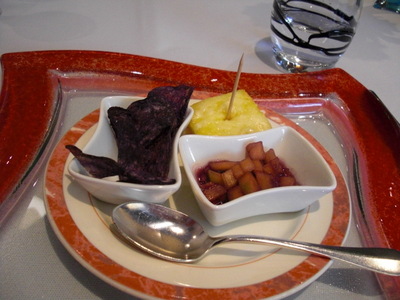
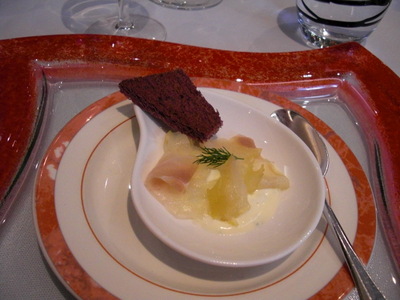 At dinner, the first amuse-bouche was this trio: a dish of house-made purple potato chips, a square of something on a toothpick (omelet, maybe? I don't remember), and a dish of diced apple cooked in a rather sour wine sauce.
At dinner, the first amuse-bouche was this trio: a dish of house-made purple potato chips, a square of something on a toothpick (omelet, maybe? I don't remember), and a dish of diced apple cooked in a rather sour wine sauce.
The second was this little dish of delicious sliced smoked haddock. We all ordered the menu at 43 euros.

 First course, David: Tourteax crabmeat and chorizo in leek "canneloni" with a sauce of sweet peppers in olive oil and accompanied by mango stewed with pepper.
First course, David: Tourteax crabmeat and chorizo in leek "canneloni" with a sauce of sweet peppers in olive oil and accompanied by mango stewed with pepper.
First course, CJ: Asparagus sautéed in meat juices with a "moelleux du pays de Bray" and crisp lettuce leaves. At the time, I assumed the yellow object in the center was an omelet, presumably the "moelleux" (i.e., soft creamy thing from the Bray country), but when I later tried to look up "moelleux du pays de Bray," I got three different definitions: a sweet wine from Bray ("moelleux" can mean "syrupy" when applied to wine), a cheese from the area, and a sort of small yellow cake! I'll have to ask CJ what it really was.
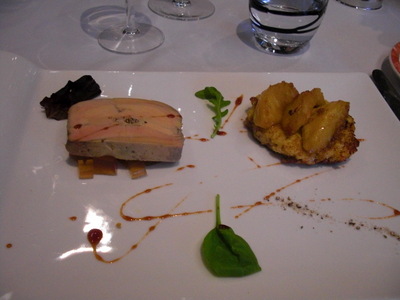
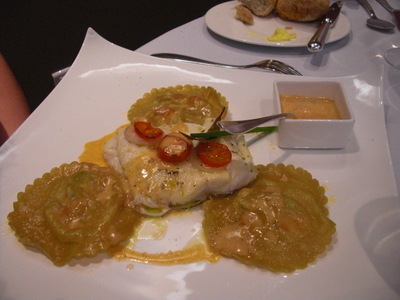 First course, me: Excellent cold foie gras with cubes of a pomeaux jelly and three slices of caramelized apple atop an outstanding round of sweet brioche French toast, crispy on the outside, creamy inside. I'm going to have to try that.
First course, me: Excellent cold foie gras with cubes of a pomeaux jelly and three slices of caramelized apple atop an outstanding round of sweet brioche French toast, crispy on the outside, creamy inside. I'm going to have to try that.
Main course, David: Fish (gray dorade, I think) with three large mixed-seafood ravioli and a creamy sauce.
Main course, CJ: Saddle of rabbit again, I think, but I seem to have failed to get a photo of it. Maybe CJ has one that I can fill in later.
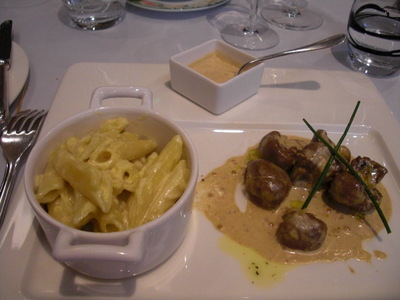
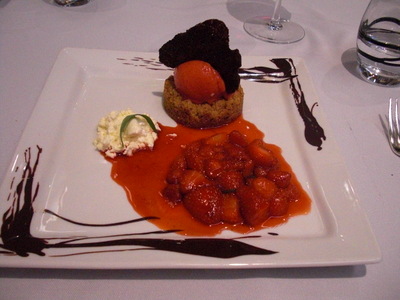 Main course, me: Veal kidneys in creamy mustard sauce, with outstanding macaroni and cheese. The kidneys were a little overcooked but not disastrously so. A very good dish.
Main course, me: Veal kidneys in creamy mustard sauce, with outstanding macaroni and cheese. The kidneys were a little overcooked but not disastrously so. A very good dish.
Dessert, me: Strawerries sautéed with tarragon. Not a very good idea, I thought. The cooking process brought out their sourness. The sheep's milk curd, the sorbet, and the hazelnut streusel cookie on the side were good, though.
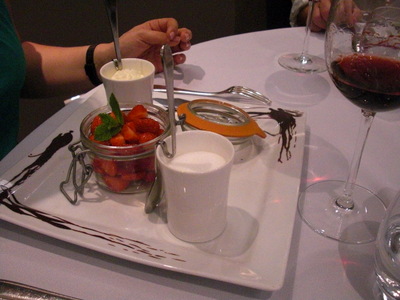
 Dessert, CJ: Every dessert on the menu contained nuts, so the chef proposed plain fresh strawberries, served simply with a bowl of sugar and another of whipped cream. I must admit I looked on rather wistfully as CJ munched her way happily through them.
Dessert, CJ: Every dessert on the menu contained nuts, so the chef proposed plain fresh strawberries, served simply with a bowl of sugar and another of whipped cream. I must admit I looked on rather wistfully as CJ munched her way happily through them.
Dessert, David: Warm toasted rhubarb pound cake with Nutella ice cream and and an infusion of chicory with "fruits of the hive," which I take to mean honey. The "chocolate" swirls around all our desserts were part of the plate.
After dinner, we went for a stroll around the square and a few neighboring block and were pleased to be reminded that it was 21 June, the date of France's annual Fête de la Musique! A few blocks over, a rather loud rock band was blaring from a raised stage while people danced in the street, but happily, in our little square, a bar had set an electric keyboard out on its small wooden deck, and an old black guy was doing a pretty good job with American tunes of the Louis Armstrong era. The crowd got particularly into singing along with a modernized version of "Swing Low Sweet Chariot." Most of the time, the keyboard was set to sound like a piano, so I suspect he was the stride player we'd heard earlier. A very pleasant evening indeed.
previous entry
List of Entries
next entry

 Before leaving the Croix d'Or, though, I took these photos of its handsome old-coaching-inn-style dining room and, in the garden courtyard, this large, very thistle-like yellow flower. I also got shots (not shown here) of the broken whirligig in the courtyard for my father (a classic man-milking-a-cow design, but its windmill was missing a vane, so we never saw in him action; my father, who designs and builds whirligigs, could have fixed it for them if he'd been there) and, nearby, a whimsical life-sized man made of scrap metal, reminiscent of the one on the FSU campus, near Oglesby Union (the one in Avranches was made in 2008 by the young people of the "Accueil de loisirs Tohu-Bohu and of Espace mosaïque, in cooperation with the artist Granvillais Marc Dupart," entirely made of salvaged materials. (An "accueil de loisirs" is a sort of vacation and after-school program, and I think "tohu-bohu" means something like "hurly-burly.")
Before leaving the Croix d'Or, though, I took these photos of its handsome old-coaching-inn-style dining room and, in the garden courtyard, this large, very thistle-like yellow flower. I also got shots (not shown here) of the broken whirligig in the courtyard for my father (a classic man-milking-a-cow design, but its windmill was missing a vane, so we never saw in him action; my father, who designs and builds whirligigs, could have fixed it for them if he'd been there) and, nearby, a whimsical life-sized man made of scrap metal, reminiscent of the one on the FSU campus, near Oglesby Union (the one in Avranches was made in 2008 by the young people of the "Accueil de loisirs Tohu-Bohu and of Espace mosaïque, in cooperation with the artist Granvillais Marc Dupart," entirely made of salvaged materials. (An "accueil de loisirs" is a sort of vacation and after-school program, and I think "tohu-bohu" means something like "hurly-burly.")
 Besides its WWII exploits, Falaise is famous for being the birthplace of William the Conqueror, son of a local girl who got involved with, but was never married to, the king. The castle where he was born is a ruin, and we didn't take time to do the tour (David and I had done it before), and the local WWII museum was gone, but by the time we got that far, we were starved. For lunch we stopped at this nameless little pizzeria, where we had an excellent lunch.
Besides its WWII exploits, Falaise is famous for being the birthplace of William the Conqueror, son of a local girl who got involved with, but was never married to, the king. The castle where he was born is a ruin, and we didn't take time to do the tour (David and I had done it before), and the local WWII museum was gone, but by the time we got that far, we were starved. For lunch we stopped at this nameless little pizzeria, where we had an excellent lunch. 
 CJ and I had terrific pizzas, her's on the left, thickly latticed with cheese, and mine on the right, topped with slices of andouille and with an egg baked on top. On each table was a graceful bottle of olive oil with a handfull of peppers in the bottom. I drizzled a little on part of my pizza by way of experiment and found that those peppers packed quite a kick!
CJ and I had terrific pizzas, her's on the left, thickly latticed with cheese, and mine on the right, topped with slices of andouille and with an egg baked on top. On each table was a graceful bottle of olive oil with a handfull of peppers in the bottom. I drizzled a little on part of my pizza by way of experiment and found that those peppers packed quite a kick!
 At dinner, the first amuse-bouche was this trio: a dish of house-made purple potato chips, a square of something on a toothpick (omelet, maybe? I don't remember), and a dish of diced apple cooked in a rather sour wine sauce.
At dinner, the first amuse-bouche was this trio: a dish of house-made purple potato chips, a square of something on a toothpick (omelet, maybe? I don't remember), and a dish of diced apple cooked in a rather sour wine sauce.
 First course, David: Tourteax crabmeat and chorizo in leek "canneloni" with a sauce of sweet peppers in olive oil and accompanied by mango stewed with pepper.
First course, David: Tourteax crabmeat and chorizo in leek "canneloni" with a sauce of sweet peppers in olive oil and accompanied by mango stewed with pepper.
 First course, me: Excellent cold foie gras with cubes of a pomeaux jelly and three slices of caramelized apple atop an outstanding round of sweet brioche French toast, crispy on the outside, creamy inside. I'm going to have to try that.
First course, me: Excellent cold foie gras with cubes of a pomeaux jelly and three slices of caramelized apple atop an outstanding round of sweet brioche French toast, crispy on the outside, creamy inside. I'm going to have to try that.
 Main course, me: Veal kidneys in creamy mustard sauce, with outstanding macaroni and cheese. The kidneys were a little overcooked but not disastrously so. A very good dish.
Main course, me: Veal kidneys in creamy mustard sauce, with outstanding macaroni and cheese. The kidneys were a little overcooked but not disastrously so. A very good dish.
 Dessert, CJ: Every dessert on the menu contained nuts, so the chef proposed plain fresh strawberries, served simply with a bowl of sugar and another of whipped cream. I must admit I looked on rather wistfully as CJ munched her way happily through them.
Dessert, CJ: Every dessert on the menu contained nuts, so the chef proposed plain fresh strawberries, served simply with a bowl of sugar and another of whipped cream. I must admit I looked on rather wistfully as CJ munched her way happily through them.